Latest news about Bitcoin and all cryptocurrencies. Your daily crypto news habit.
Nearly 4,000 developers from around the world elevated Web3 using the Internet Computer. Here are the winning projects.
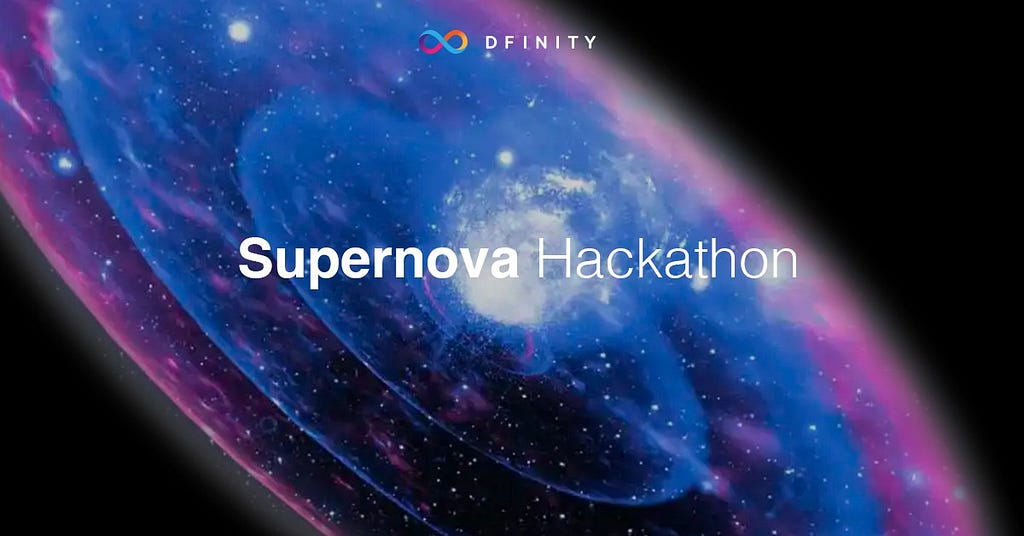
The Internet Computer blockchain’s inaugural Supernova Hackathon welcomed nearly 4,000 developers and entrepreneurs who participated from around the world, building dapps, services, and tools using the most advanced Web3 platform in existence today. The event saw teams compete for an aggregate prize and funding pool of $6 million — $765,000 in cash prizes, $765,000 in grants, and up to $4,470,000 in seed funding opportunities.
Developer teams delivered over 400 unique IC-based submissions, from which 42 finalists were elected to demonstrate their projects to notable third-party judges. Judges and partners included Andreessen Horowitz, Polychain Capital, Electric Capital, Huobi, Warburg Serres Investments, IRONGREY, SNZ, HashKey Capital, Fenbushi Capital, FBG CapitalBinance Labs, KR1, Messari, dao5, Scalar Capital, Amino Capital, Unity Technologies, Polygon, Chainlink Labs, SV Angel, Anmi Capital, Tomahawk, BlackComb Software, ASI GIG, Foresight Ventures, IOSG Ventures, BeInCrypto, CV VC, ICPort, Braintrust, Simplex, Spiral, Unstoppable Finance, Blockrocket, and more.
Prizes were awarded across six tracks that included SocialFi, GameFi, Metaverse and NFTs, Asynchronous DeFi, Public Good/Social Impact, and Blue Sky. A list of the winners follows below.
From the top winners the judges selected two Grand Champions: Cubetopia, a Minecraft-inspired play-to-earn role-playing game with the potential to migrate millions of users to Web3; and Spinner Cash, project that uses zero-knowledge proofs and a private ledger to help users make private Bitcoin or ICP transactions. Both projects stood out amid a crowded field of Supernova projects that elevated the Web3 movement using the Internet Computer.
The Supernova Community Choice Award is still up for grabs, with voting taking place via the social platform DSCVR. Voting is open from July 1 through July 10, with the winner being announced on July 11 and receiving a $10,000 cash prize and a $5,000 grant.
- Don’t have an Internet Identity yet? Get your Internet Identity
- Not on DSCVR yet? Sign up with your Internet Identity
Supernova Grand Champions
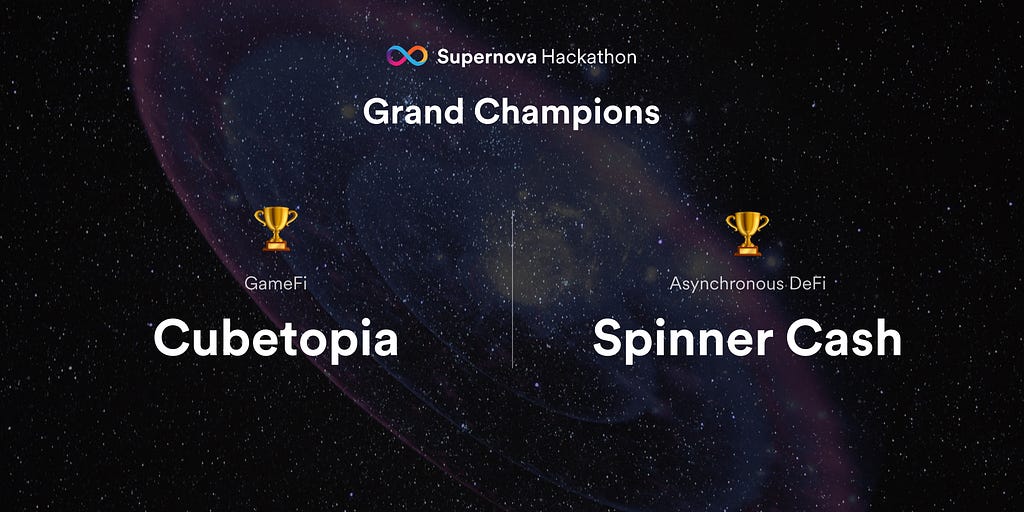
Cubetopia
“Cubetopia seeks to be the first fully decentralized multiplayer RPG/sandbox game built on the Internet Computer. Cubetopia will allow users to express their creativity on their own unique island on the blockchain. Cubetopia’s mission is simple: we want to create a game that is fun and engaging for players as a unique way to onboard more people into the Web3.0 space. We are aiming to create a game that feels familiar and intuitive to as many players as possible. We want to spark both creativity and a sense of adventure within our players.”
Spinner Cash
“Spinner Cash implements a private ledger on which all transactions are 100% private. It does not reveal the sender or receiver of a transaction, nor the amount of tokens being transferred. Therefore, transactions conducted on the private ledger is 100% private. Similar to UTXOs, Spinner’s ledger stores private notes instead of account balances or user address. Only a note’s owners know the secret and can prove their ownership. To spend a note (for example, sending tokens to another account), a user has to first prove that she is the owner of the input note. The Spinner ledger will verify this proof before approving the transaction.”
SocialFi
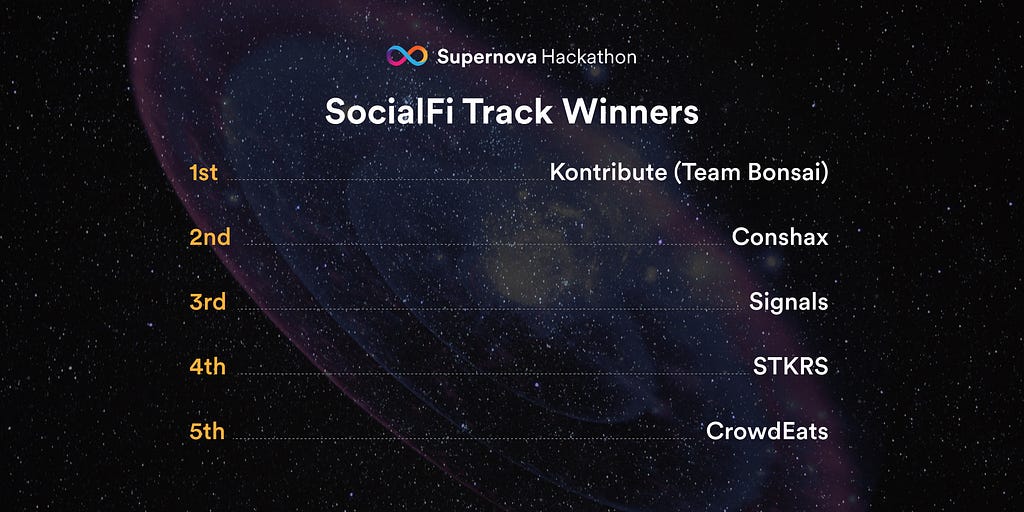
1st Place: Kontribute
“Kontribute allows readers, writers, and Web3 enthusiasts to write and read stories, as well as sell and trade NFTs from their stories, all within our dapp. To achieve this we have integrated a creative writing feature, a story section, and an ICP wallet in the dapp — users can directly hold their NFTs and ICP all within Kontribute. Kontribute gives writers a place to share their stories with a community and a way for them to sell NFTs from their stories. Readers may want to support an author’s story by purchasing their NFTs. Larger projects with large stories and a large collection of NFTs can also launch stories and NFTs on the dapp via our launchpad.”
2nd Place: Conshax
“Conshax enables Web3 native on-chain hosting for Podcasting 2.0, and it enhances the standard’s RSS value tags by turning them into tradable tokens of podcast episodes. In doing so, Conshax enables the automatic distribution of Lightning payments according to the token split structure of an episode. Thereby, we combine Web2 and Web3 through the integrated Podcasting 2.0 access. We offer new monetization opportunities for podcasters, and we enable token-based community interaction.”
3rd Place: Signals
“I was inspired to build Signals after moving to a new city and finding it hard to connect with new people. It occurred to me that I pass the same strangers every day who share my interests and hobbies — we live in the same building, go to the same gym, enjoy the same cafes or play the same sports. Signals presents an opportunity to re-think social media to put connection at the heart. Signals is built as a DAO, meaning that its users control how it operates and are incentivized through the Signals Token to interact with the map and maintain the quality of the data. Currently it supports leaving three types of signals — Chats, Trades and Events. Any user with sufficient tokens can see the state of the system, and make proposals on how Signals should be run.”
4th Place: STKRS
“Vitalik Buterin wrote a paper a few weeks about a concept he dubbed Soul Bound Tokens, and we were inspired by the impact the concept could have and immediately started iterating. We believe there’s a lot of problems facing the industry today, with lack of trust online being the biggest cause. We want to solve this problem, and through the presentation we talk about how our product solves the issue of trust, improving the whole Web3 experience along the way. Each user is granted a ‘stkr wall’ upon signup, where they can showcase NFTs in the form of ‘stkrs’ that highlight their professional experience, communities they’re a part of, or fun activities that they like to engage in. Stkrs are minted by organizations which get approved for stkr minting by the stkr DAO, verifying that organizations issuing stkrs are legitimate.”
5th Place: crowdEats
“crowdEats is a Web3 reimagining of how we find, curate, moderate, evaluate, and more generally interact with local businesses on the internet. It leverages tokenization and community juries to create a scalable, decentralized review moderation mechanism. On top of that, it offers users a food-based social media running entirely on the blockchain, which unlocks new ways to curate and monetize content that aren’t possible in Web2.”
GameFi
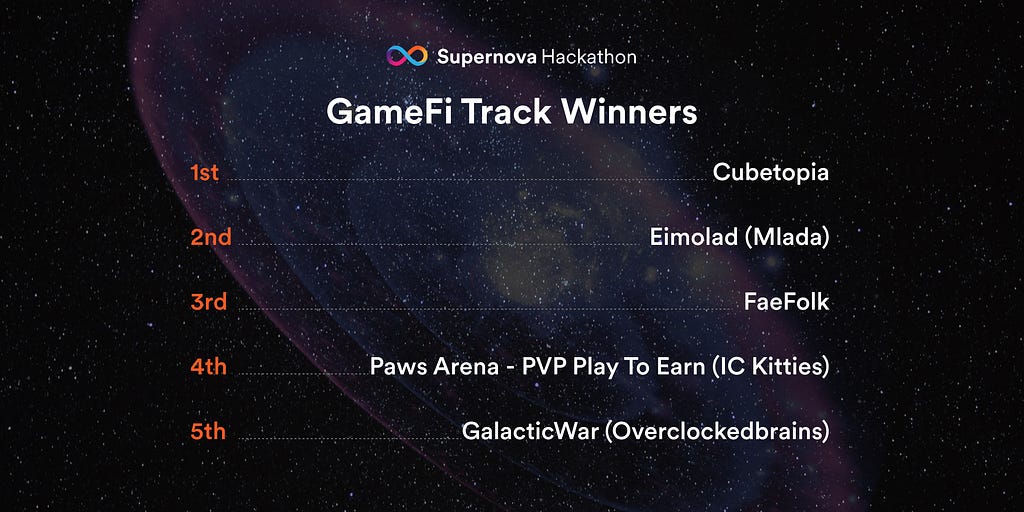
1st Place: Cubetopia
“Cubetopia seeks to be the first fully decentralized multiplayer RPG/sandbox game built on the Internet Computer. Cubetopia will allow users to express their creativity on their own unique island on the blockchain. Cubetopia’s mission is simple: we want to create a game that is fun and engaging for players as a unique way to onboard more people into the Web3.0 space. We are aiming to create a game that feels familiar and intuitive to as many players as possible. We want to spark both creativity and a sense of adventure within our players.”
2nd Place: Eimolad
“We are creating Eimolad, an MMORPG NFT game fully deployed on the Internet Computer. The game is not ready yet, but now you can walk around our first location. Characters of different races will fight against game monsters and against each other. They can form groups and alliances for greater efficiency. The more a character plays, the faster his game level and skills grow. Game attributes can be improved with weapons and equipment that can be bought or crafted using game resources. Weapons and attributes can also be bought or sold on the game Market using ICP tokens and eGOLD. We will add updates as we achieve the development goals.”
3rd Place: FaeFolk
“Faefolk was inspired by Stardew Valley, a pixel-style, slice of life game that has been enjoyed by gamers for over 10 years. We wanted to bring this experience to the blockchain, and the Internet Computer was the most effective path to bring the vision to life. In its current iteration, Faefolk allows users to farm, craft and build in a multiplayer, procedurally generated, persistent world. While much of what it will be is not yet built, the internet computer offers a unique opportunity to enhance game play loops by incorporating blockchain technology into the user experience. The current demo will demonstrate the minting of real NFTs by harvesting trees and stone, along with a procedurally generated world that users can play in with their friends.”
4th Place: Paws Arena
“We first started our project in September of 2021 in the form of an NFT collection, named ICKitties. In order to make it easier for our audience to follow our story, we created a 90 second animated video showcasing the background of each kitty race in a fun and easy to follow way. Now, our NFT collection will find a new home in Paws Arena, our upcoming game. We noticed that no other project on the Internet Computer had a challenging multiplayer feature or any system that would give players a reason to come back and play again. That is why we created Paws Arena to allow users to connect in multiplayer PVP fights and get rewards every time they win a match.”
5th Place: GalacticWar
“GalacticWar is a play-to-earn game that is powered by the Internet Computer blockchain. The community can contribute and earn in a variety of ways, including but not limited to playing the game, live-streaming gameplay, and staking weapons, as well as selling on secondary marketplaces. The core of the game lies in creating your own base and looting other bases to earn Aureus (an in-game DIP20 token). All the elements in your base are DIP20 tokens that can also be sold on a DEX. You own your assets. There are special purpose miners which help players to mine in game currencies at a certain rate. There are attackers which players can buy to loot other bases.”
Metaverse & NFTs
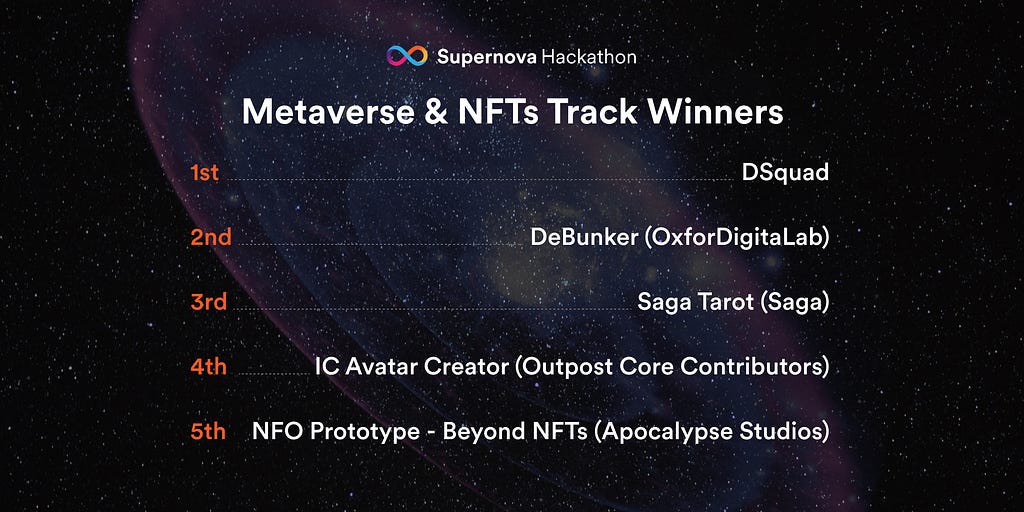
1st Place: dSquad
“The NFT industry is full of projects with capped supplies that exclude users and assets which only benefit the dev team of a single dapp. We wanted to create something which changed this completely: an NFT project that is accessible to everyone and focused on gamifying the entire Internet Computer ecosystem. Anyone can join dSquad by minting a personalized Avatar for a low flat rate of 1 ICP, and as long as they keep this NFT in their wallet it gives them a chance to earn prizes in monthly airdrops (both with prizes from our collection and partnering projects) as they use the Internet Computer. They can complete “missions” on various dapps across the ecosystem and engage with other projects to increase their rank on a leaderboard and improve their odds for winning prizes.”
2nd Place: deBunker
“deBunker is another crucial step on the road to decentralised, community-owned immersive VR spaces. Built by the creators of The Island Collective, it strives to go one step further in terms of interaction, communication and performance. In a move away from the tropical topside, this steel and concrete subterranean shelter has several game rooms, each containing one of our current experiments. The main attraction is a two-player baseball trainer, where one person takes charge of loading the pitching machine while the other gets in some batting practice.”
3rd Place: Saga Tarot
“Saga’s initial purpose is to bring a delightful, faithful digital tarot experience to existing tarot fans, and to do it in a way that enables and encourages open contribution and participation at all levels. We do this by first establishing the groundwork for interoperable tarot goods and services (NFTs and dApps) as a suite of open source software and SDKs.”
4th Place: IC Avatar Creator
“The IC Avatar Creator is a project that enables users to mint their own Avatars for the metaverse and store them fully on-chain. The project is 100% on-chain and leverages the power of the canister architecture to provide a seamless experience for users. The aim of this project is to provide newcomers to the open metaverse with a way to express their identity through a 3D avatar that they can own and use on a wide variety of platforms. Hosted entirely on-chain via IC, users are able to create their avatars as NFTs and secure or trade them using a crypto wallet and decentralized identity. Users can view their avatar from the same canister the assets are stored in, and even inspect it interactively in Plug wallet. This provides a unique and powerful solution for users who wish to have greater control over and connection to their online identity.”
5th Place: Apocalypse NFO Prototype
“Going beyond the concept of NFTs, we propose the concept of Non-Fungible Objects (NFOs), which have all intrinsic value of purchases for the user, giving true secure ownership of their items. The Apocalypse Studios NFO Prototype enables the storing of complicated data describing the properties of objects, which have actions and can mutate in a structured manner. It includes a predicate language for expression permissions on objects, allowing for both machine verification of the validity of transactions and human interpretation of the value proposition of an action.”
Asynchronous DeFi
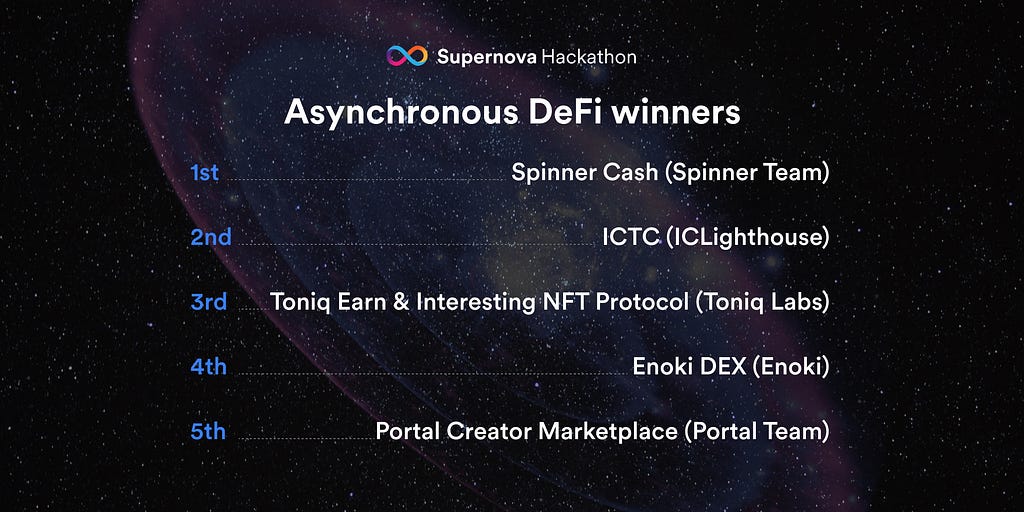
1st Place: Spinner Cash
“Spinner Cash implements a private ledger on which all transactions are 100% private. It does not reveal the sender or receiver of a transaction, nor the amount of tokens being transferred. Therefore, transactions conducted on the private ledger is 100% private. Similar to UTXOs, Spinner’s ledger stores private notes instead of account balances or user address. Only a note’s owners know the secret and can prove their ownership. To spend a note (for example, sending tokens to another account), a user has to first prove that she is the owner of the input note. The Spinner ledger will verify this proof before approving the transaction.”
2nd Place: ICTC
“ICTC is a distributed transaction framework for Defi applications on the IC network. ICTC consists of Transaction Manager (TM), Task Actuator (TA), and Transaction Compensator (TC). Transaction Order: A transaction, including one or more transaction tasks, that requires all tasks to be either fully successful or fully rejected. Transaction Task: A task within a transaction, including local tasks of the caller and remote tasks of other parties involved.”
3rd Place: Toniq Earn & Interesting NFT Protocol
“Toniq Earn’s goal is to provide yield in a more liquid form than the NNS, provide interest rates that are substantially higher than Sonic’s liquidity pools, and give NFT accumulators a place to go to leverage their NFTs for additional liquidity. Toniq Earn is powered by the Interesting NFT Protocol, a decentralized interest rate protocol.”
4th Place: Enoki DEX
“Enoki is a decentralized xchange that allows users to swap tokens, provide liquidity, trade using limit orders, and act as a market maker. A user signs up to the exchange and is assigned a broker. The user can submit limit orders to the broker, which are then executed by the exchange after a synchronization round. Users can also lock liquidity into a Liquidity Pool. Brokers have access to this liquidity, which is available for swapping at prices determined by the bid-ask curve of the limit orders in the exchange. This way, users are also able to instantly swap tokens with any broker, without having to wait for any exchange synchronization.”
5th Place: Portal Creator Marketplace
“Created for the Supernova Hackathon using Portal technology and powered by the Internet Computer. The Portal Creator Marketplace is a video NFT platform that is hosted and running on the Internet Computer blockchain. Feel free to interact with the marketplace and check out the functionality. Buy a Royalty Token, purchase a video rental, and see the revenue split deposited to your wallet.”
Public Good / Social Impact
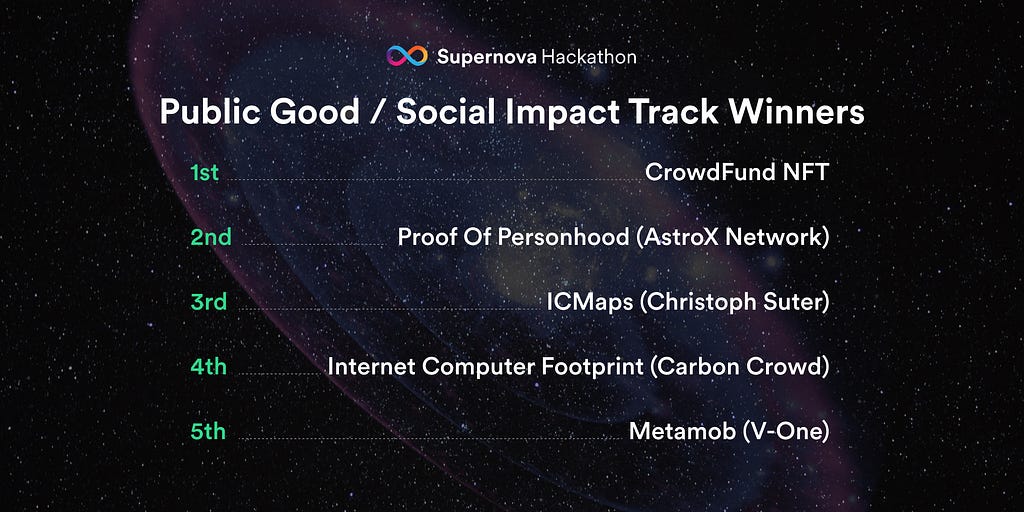
1st Place: CrowdFund NFT
“We are CrowdFund NFT — an alternative to Kickstarter, Go Fund Me, and other traditional crowdfunding platforms. Our unique approach? We run entirely on the Internet Computer blockchain, and use NFTs to provide fundraisers with ‘proof of participation’ in the projects they back. This allows us to create a safer, cheaper and global crowdfunding service.”
2nd Place: Proof of Personhood
“Proof of Personhood is a Sybil-proof identity system powered by decentralized AI human detection. It allows:
- a user to verify he or she is not a bot by answering a combination of random challenges with sequential simple human actions like simultaneous face gestures and speaking numbers;
- dApps or Web2.0 apps can prevent Sybil attacks by requiring users to complete Proof of Personhood via QR Code Authentication;
- Privacy preserved. No sensitive information (user face image or voice) ever leaves the user’s device. The on-device AI algorithm and the algorithm running on the IC canister together perform a Reverse Turing Test, in a decentralized way.”
3rd Place: ICMaps
“ICMaps brings maps to the Internet Computer. With ICMaps you can create your own map servers and thus integrate map layers into Web3 Dapps, Web2 applications and even desktop GIS. ICMaps is on the one hand the software that can be installed on own canisters and enables a decentralized, scalable map server that is fully compatible with the standard WMTS. On the other hand, the ICMaps.org frontend provides a user-friendly interface to create custom map servers and load map tiles from existing maps into the blockchain. This allows maps to be created with just a few clicks. Many examples show the potential of Web3 maps. One example impressively shows the effects of climate change by directly comparing two glacier levels.”
4th Place: Internet Computer Footprint
“Internet Computer Footprint uses verified carbon credits to offset IC projects on-chain. We have developed a methodology to calculate the entire emissions of the IC and then, using cycles, determine the carbon emissions of specific projects operating on the IC and provide a route to account for those emissions. We started the IC footprint to support the IC move towards a more environmentally conscious future. In our mind, a prerequisite for making the IC a force for good in the world is to ensure that we develop it in a way that considers its impact on the planet. We see IC footprint as the first step in a journey to harness the unique capabilities of the IC to help tackle climate change.”
5th Place: metamob
“Metamob is a decentralized web3 app, running on the Internet Computer, that lets any user start mobilizations by creating campaigns of four different kinds: donations, votes, signatures and fundraising. Using metamob users can create campaigns to face real world problems like climate change, wars, oppression, inequality, or even to fix specific issues on his school or his condo, for example. Thanks to the Internet Computer and its 100% on-chain apps, metamob doesn’t depend on web hosts and can’t be controlled or censured by governments.”
Blue Sky

1st Place: Kinic
“Kinic is my answer to the problem of discoverability for web3 apps and content. I was inspired to build it because I was seeing content being made but having little chance of being discovered. Not because of quality, or variety of the content, but by the systems of centralized gatekeepers. These systems are in the interest of the status-quo. The gatekeepers do not mind to care.”
2nd Place: CanDB
“CanDB is the first flexible and truly horizontally scalable NoSQL database built for the Internet Computer. CanScale is an initiative to build scalable distributed infrastructure for the Internet Computer (IC) blockchain. CanScale’s first project, CanDB, is non-relational, performant, and horizontally scalable multi-canister database. CanDB provides a familiar and flexible NoSQL API that abstracts and automates multi-canister spin up & auto-scaling, data partitioning, and data persistence and stability. This enables developers to focus more on application development and less on IC specific distributed data storage design.”
3rd Place: FoxIC
“FoxIC allows users to use MetaMask to sign IC messages and interact/control a wallet canister to send ICP transactions, and display ICP balance inside MetaMask, as well as transaction history. IC messages are signed inside MetaMask, not within a WebApp’s frontend page. So it’s more secure and the same usage pattern that users are already familiar with. The user’s private/public key pair i.e. identity, stored in MetaMask, is used directly for the signing function, just like any extension crypto wallet. The identity then can be used to interact with canisters, and even control the user’s own canisters. With this MetaMask/IC signing integration, building a frontend IC wallet app becomes straightforward, allowing MetaMask users to own and control their canister wallets.”
4th Place: DeTi: Decentralized Time Travel
“The Internet Computer, by being compute-first, allows functionality that is outside the boundaries of what a data-first blockchain like EVM is capable of. DeTi is a decentralized cron scheduling service that will fire off a message to a designated canister on a specific function endpoint on a schedule or at a time designated by the user. We wrangled the date work so you would not have to: run your function every day at 5pm. Or every Tuesday at 9:23pm. Maybe just once next Saturday at 11. No matter your scheduling needs, you can compose them using DeTi. With DeTi, unstoppable canisters become unstoppable robots.”
5th Place: Internet Computer Services
“At its core Internet Computer Services (ICS) provides easy creation and management of atomic units in IC called Canisters. But the realm of ICS expands to the scale at which AWS / GCP offers services in Web2. ICS aims to provide small, independent, developer-owned services that will become building blocks of dApps. 100% on-chain deployed queue service, secret manager etc., are some of the services ICS aims to provide and continuously add more as the community requires. Apart from these services, ICS aims at providing 1-click deployment of dApps available in the marketplace, minting of NFTs, token generation for any new project, and provisioning on-chain BTC and ETH wallets with few simple clicks. ICS will support many more upcoming native integrations in the future, like SNS.”
____
Start building at internetcomputer.org and join the developer community at forum.dfinity.org.
Announcing the Winners of the Internet Computer’s Supernova Hackathon was originally published in The Internet Computer Review on Medium, where people are continuing the conversation by highlighting and responding to this story.
Disclaimer
The views and opinions expressed in this article are solely those of the authors and do not reflect the views of Bitcoin Insider. Every investment and trading move involves risk - this is especially true for cryptocurrencies given their volatility. We strongly advise our readers to conduct their own research when making a decision.